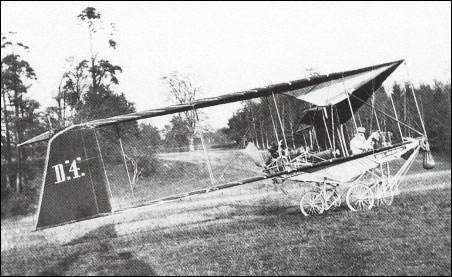|
| There is no text information for this aircraft at the moment.
| Brian Johnston, e-mail, 27.05.2012 12:31 I've been doing some research into the Dunne aircraft. He built not only a biplane, but also a monoplane version of this aircraft. The designs were taken up by one of the french manufacturers (Nieuport I seem to remember) as well as Burgess in the USA who built it as a floatplane. The main point about this craft was it's amazing stability in flight. Controls consisted of two levers; one for each elevon (ailreron and elevator combined). There was no seperate rudder. Turning was achieved by pushing one elevon up and the other down and thhe aircraft would bank into the appropriate turn. If you then locked the levers in that position, the aircraft would continue quite happily to fly in circles without any further input from the pilot! Similarly with both levers locked in the neutral position it would fly happily straight and level. It also had the quality that if for some reason it started to lose airspeed it would out itself into a shallow dive until the correct airspeed was regained. The design was eventually shelved, bit later had the dust blown off and brought up to date by Westland as their Pterodactyl series. A good deal of information as well as 3-view drawings can be gleaned from the pages of "Flight Global Archive" which has on-line scanned copies (almost) every issue from 1909 to 2009.
Brian Johnston reply | | Terrence I. Murphy, e-mail, 10.02.2012 00:53 The wings of D. 1 glider were used to build The Dunn D.4 in conjunction with a new tubular steel structure incorporating a sprung four wheel undercarriage, also providing the housing for the powerplant. This was a REP fan-type semi-radial, driving a pair of steel pusher propellers through flat belts, one of which was crossed. The transmission incorporated a clutch, and the shafts carrying the belt pulleys were supported at both ends. The propellers, whose blades were adjustable for pitch, were 6ft diameter originally, but were later reduced to 5ft 7in. The wingtip interplane struts were covered in fabric to form side curtains.
The machine seems to have been assembled for the first time at Blair Atholl and trials took place there between 15 November and 4 December 1908. Straight runs only were made reaching a maximum of 40 yards airborne distance.
This was the last machine made by the Balloon Factory and was given to Dunne, less the engine, upon his discharge.
Power: 25hp REP seven-cylinder air-cooled, fan-type semiradial driving twin pusher propellers
Data
Wing area: 504 sq ft
Weight: 1,035 1b reply | | Paul Willson, e-mail, 16.10.2011 02:23 A floatplane went to UK with the Canadian Expeditionary force in 1914.Never saw combat disappears on Salsbury Plain before the CEF went to France. reply | | Duke Horn, e-mail, 03.12.2009 16:53 The Burgess-Dunne AH-10 thru 14 were Navy version designations of this design with a single pontoon and tip floats. A great 45 bonus point power scale airplane for Flying Aces Competion. Make it for electric or gas. reply |
|
Do you have any comments?
|
| |









